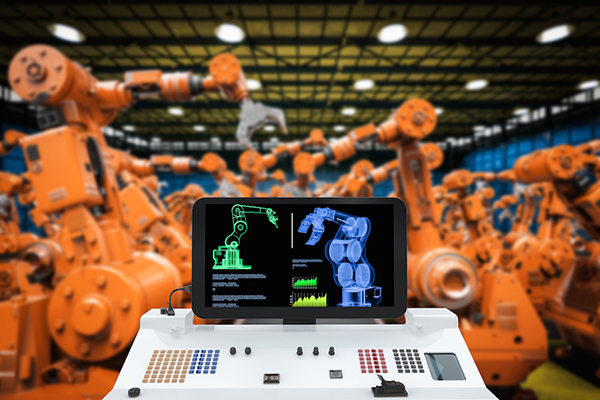Advances in robotics and artificial intelligence are gathering pace, prompting many economists to warn of mass automation and impending economic strife. A new RSA project asks whether they are right to be worried, or whether in fact the new machine age could be the perfect reprieve for blue collar workers struggling with insecurity and low-pay.
Here come the robots
“The current moment in the field of robotics is very much like where the world stood with the Internet 20 years ago. We are at the beginning of something: chapter one, page one.” – Alec Ross
Of all the innovations set to transform the 21st century labour market, few have received more attention than robotics and artificial intelligence. Recent books such as The Second Machine Age (Brynjolfsson and McAfee), Industries of the Future (Ross) and Rise of the Robots (Ford) predict that a new wave of technologies will soon transform the nature of work, possibly beyond recognition. From driverless cars and surgical robot assistants, through to automated food pickers and chatbot retail helpers, nearly every industry is set to be affected in some way by oncoming advances in machine technology.
Not everyone is in agreement about the consequences. Pessimistic writers like Martin Ford warn of mass automation across the board, followed by a surge in unemployment and broader economic and political strife. This view is supported by an Oxford University study estimating that 47% of all occupations in the US could be at risk of obsolescence in the next two decades. Others such as Geoff Colvin disagree, arguing that we tend to “overweight the reality of the disappearing jobs and underweight the reality of the new ones”. Techno-optimists of his kind point to the experience of history, which has shown that in the long-run technological change often ushers in better jobs, new products and greater economic prosperity.
As these two sides battle it out, a more sophisticated debate has started to take shape. Academics and economists are moving beyond aggregate assessments and beginning to drill down into the particulars of which groups are likely to be affected and how. A great deal of attention has been paid to middle-skilled workers, such as skilled tradesmen, accountants, paralegals, sales staff and others for whom information gathering and analysis is central to their work. The now familiar ‘hollowing out’ thesis argues that occupations such as these are at most threat from robotics and artificial intelligence, in part because many of their tasks are repetitive and their wages high enough to warrant investment in capital substitutes.
Bots and blue collared workers
Less considered, however, has been the impact of robotics and artificial intelligence on low-skilled workers, of which there are 13.9 million in the UK, or 45 percent of the workforce. Jobs such as caring, cleaning, taxi driving, shelf stacking and waitressing were once thought too complex for machines to mirror (in terms of the dexterity and movement involved). Yet new technology is coming on stream that is set to challenge those assumptions. Advances in modelling ‘belief space’ has led to breakthroughs in situational awareness and the ability of robots to grasp objects and replicate hand-to-eye coordination. Meanwhile, developments in materials science and the use of air muscles and ‘ferrofluids’ have made robots more life-like and dexterous.
Driverless cars represent the pinnacle of these innovations, combining laser surveying technology, sensors, high definition mapping systems and state of the art software. The majority of car makers and tech giants now have their own programmes for developing self-driving vehicles, and it may not be long before they become a common sight on our roads. In healthcare, too, new robots are coming to market that promise to deliver types of care once thought beyond their reach. Tokai Rubber Industries in Japan has developed the Robot for Interactive Body Assistance (RIBA), which can lift and move humans up to 175 pounds in weight. Honda’s ASIMO robot can assist patients to get out of bed and engage in simple communication.
All of this comes at a time of significant challenges for low-skilled workers, many of whom have found themselves at the sharp end of a slow economic recovery. Three in five elementary workers were low paid in 2014, as were two in five workers in personal services. Added to the problem of stubbornly low wages is the wider phenomenon of insecurity and precariousness. According to the OECD, almost all the aggregate increase in employment in the UK since 2007 is owed to ‘non-standard jobs’, such as part-time work, ‘flexible’ contracts and zero-hour contracts. This may be one reason why the proportion of people in ‘routine’ and ‘semi-routine’ jobs who say they are stressed more than doubled in the last decade.
Three reasons to be hopeful
The question is whether advances in robotics and artificial intelligence will exacerbate these trends or alleviate them. On the surface, the answer is obvious: machines are becoming more sophisticated and affordable, and that can only mean the displacement of workers. It is easy to imagine driverless cars pushing the UK’s 210,000 taxi drivers out of business, just as it is easy to picture self-service checkouts diminishing the need for many of the country’s 1.1 million retail workers. More capable ‘picking and packing’ robots in factories should also, in theory, come at the expense of the nation’s 1.3 million logistics employees.
In practice, however, the unfolding of the new machine age is unlikely to be so clear cut. Putting the question of technical feasibility to one side – a big question in itself – there are several reasons why robotics and artificial intelligence may not prove to be the job destroyers many fear:
Cultural and moral sensitivities – Society has an established set of moral and cultural touchpoints that will limit our adoption of robotics and AI. While few people would take issue with using automated call centres to book appointments or organise banking services, many may harbour concerns over the use of new machines in healthcare and education. For example, patients are unlikely to accept an illness diagnosis or treatment prescription from an AI interface without a second opinion from a human. Matters of life and death will not be left to machines.
Augmentation over substitution – Many technological advances will serve to support existing workers rather than displace them. The RIBA robot is designed to assist carers in lifting patients, while many customer relationship management (CRM) systems are intended to help retail sales teams, not usurp them. McKinsey argue that the story of robotics and artificial intelligence is mostly one of task automation rather than whole-job automation. This is one reason why a recent OECD study found that only 9 percent of jobs are at risk of automation, contradicting the 47 percent figure put forward by Oxford University.
The prospect of new occupations and industries – The experience of history tells us that new types of work are likely to emerge in the face of technological upheaval, just as they did in society’s transition from agriculture to manufacturing, and thereafter to services. While it is difficult to predict what new occupations and industries are on the horizon, many foresee a future labour market bound up in emotional services, where empathy, authenticity and creativity come at a premium. As Julia Kirby and Thomas Davenport put it, machines that have up until now been “the brawn to our brains, can become the brains to our brio”.
We should also consider the macro-economic impact of a new machine age. With sluggish productivity growth a defining feature of the UK economy, there is a pressing need for greater investment in capital expenditure, of which robotics and artificial intelligence will form a core part. A productivity boost would not only increase the chances of a return to real wage growth for low-skilled workers, it could also serve to reduce prices of consumer goods and make affordable products that were once only available to high earners. A good example is of robo-advisory services in finance, which could open up financial advice to the masses.
Preparing for the unknown
None of this should be to dismiss economists and others who harbour concerns about the impact of AI and robotics on the labour market. Writers such as Martin Ford may well be correct to say that the latest wave of technological change will turn out to be qualitatively different than the ones that preceded it. We should also stress that the labour market is incredibly diverse, with different sectors and subsectors likely to be affected by new machines in varying ways. What is true of technology’s impact in healthcare may not be true of its impact in logistics, cleaning, tourism, construction or retail.
Indeed, the fear of automation – whether justified or not – has already begun to play out in the political arena. A fascinating analysis of the US election results by FiveThirtyEight found a strong correlation between the likelihood of a county voting for Trump and the proportion of jobs that are routine (and therefore susceptible to automation). Closer to home, Labour has sought to present itself as the party that will protect workers from automation, and recently launched a Future of Work Commission to explore how policymakers can best respond.
Against this backdrop, the RSA is starting a new project to bring clarity to the AI and robotics debate, paying particular attention to the opportunities and challenges at the low-skilled end of the labour market. What are the technologies that are likely to have the greatest impact on this group? How are blue collar workers in different occupations and industries likely to be affected? What might low-skilled work look like in the future, assuming the very category and meaning of ‘low-skilled’ continues to be useful? And how might welfare, education, design, employment services and other support systems be reconfigured to run with the grain of a new machine age? These are just some of the questions we will be exploring over the coming months.
In doing so, our aim will be to cut through the hyperbole and offer a clearer account of what these technologies are, what they are capable of, and what may come next in terms of new work and sectors. At this early stage in the development of robotics and AI, we have an opportunity to inform public opinion with more thoughtful conversations grounded in evidence and absent of ideology. Push robotics and AI too far away and we could deprive ourselves of a surge in living standards and a growing economic market, yet blindly embrace the new machine age and we may inadvertently load new pressures on our society, particularly the already vulnerable.
It is critical we get our response right.
Related articles
-
8 key takeaways from our new report on AI, robotics and automation
Benedict Dellot
AI and robotics are challenging human supremacy in a growing number of tasks. Will these technologies lead to the decimation of jobs? Or could they take us to a better world of work?
-
A Hippocratic Oath for AI developers? It may only be a matter of time
Benedict Dellot
Developments in artificial intelligence and robotics are picking up pace. But are policymakers and regulators ready for the ethical fallout?
-
Pensions coverage for the self-employed is pitiful – but it’s never too late to start nudging
Benedict Dellot
Pension coverage for the self-employed is pitiful, with just a fifth signed up to a private scheme. Could nudging be part of the answer?




Join the discussion
Comments
Please login to post a comment or reply
Don't have an account? Click here to register.
A case in point: https://www.wired.com/2016/10/ubers-self-driving-truck-makes-first-delivery-50000-beers/
Take a look, and wonder how the company behind the development (Uber-purchased Otto) can say it doesn't want to put anyone out of work. There are something like two million long-haul truckers in the US alone, and if I were one of them I'd be wondering just how long my job may last.
Many outdated concepts in this.
Spend 1 hour searching Google for Tech articles related to global automation, and how close it is to reality. Automation has been evolving at an incredible rate. It doesn't require any more "breakthroughs" to become reality. The changes are already in progress. More breakthroughs will simply speed up the time-line.
I strongly urge the RSA to revise it's new program to look at "the whole picture".
We need our economists to FEVERISHLY work on an entirely new economic system within the next 5 years.
ALL jobs, low, medium and high level, will be gone in less than 25 years, with almost no exceptions, but the demise of the current economy will happen much faster than that.
When we reach a 30% global unemployment level, the current system won't be able to sustain itself. Temporary new jobs will be automated before they ever become a reality.
The automation of vehicles will likely be the first industry/sector to begin the process of ending our current economic system. Based on already existing technology and trends, this will likely occur in less than 10 years.
I cannot stress enough that global automation is not in the "distant future". It is nearly on our doorstep.